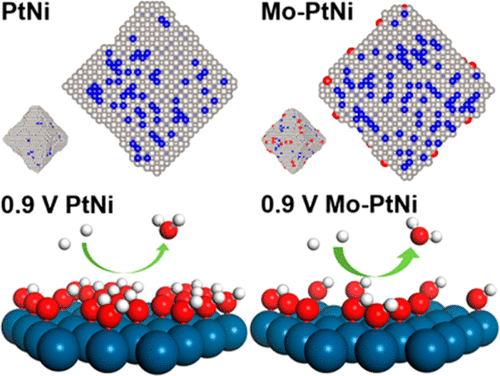当前位置:
X-MOL 学术
›
Nano Lett.
›
论文详情
Our official English website, www.x-mol.net, welcomes your
feedback! (Note: you will need to create a separate account there.)
Roles of Mo Surface Dopants in Enhancing the ORR Performance of Octahedral PtNi Nanoparticles
Nano Letters ( IF 9.6 ) Pub Date : 2018-01-03 00:00:00 , DOI: 10.1021/acs.nanolett.7b04007 Qingying Jia 1 , Zipeng Zhao 2, 3 , Liang Cao 4 , Jingkun Li 1 , Shraboni Ghoshal 1 , Veronica Davies 1 , Eli Stavitski 5 , Klaus Attenkofer 5 , Zeyan Liu 2, 3 , Mufan Li 3, 6 , Xiangfeng Duan 3, 6 , Sanjeev Mukerjee 1 , Tim Mueller 4 , Yu Huang 2, 3
Nano Letters ( IF 9.6 ) Pub Date : 2018-01-03 00:00:00 , DOI: 10.1021/acs.nanolett.7b04007 Qingying Jia 1 , Zipeng Zhao 2, 3 , Liang Cao 4 , Jingkun Li 1 , Shraboni Ghoshal 1 , Veronica Davies 1 , Eli Stavitski 5 , Klaus Attenkofer 5 , Zeyan Liu 2, 3 , Mufan Li 3, 6 , Xiangfeng Duan 3, 6 , Sanjeev Mukerjee 1 , Tim Mueller 4 , Yu Huang 2, 3
Affiliation

|
Doping with a transition metal was recently shown to greatly boost the activity and durability of PtNi/C octahedral nanoparticles (NPs) for the oxygen reduction reaction (ORR), but its specific roles remain unclear. By combining electrochemistry, ex situ and in situ spectroscopic techniques, density functional theory calculations, and a newly developed kinetic Monte Carlo model, we showed that Mo atoms are preferentially located on the vertex and edge sites of Mo–PtNi/C in the form of oxides, which are stable within the wide potential window of the electrochemical cycle. These surface Mo oxides stabilize adjacent Pt sites, hereby stabilizing the octahedral shape enriched with (111) facets, and lead to increased concentration of Ni in subsurface layers where they are protected against acid dissolution. Consequently, the favorable Pt3Ni(111) structure for the ORR is stabilized on the surface of PtNi/C NPs in acid against voltage cycling. Significantly, the unusual potential-dependent oxygen coverage trend on Mo-doped PtNi/C NPs as revealed by the surface-sensitive Δμ analysis suggests that the Mo dopants may also improve the ORR kinetics by modifying the coordination environments of Pt atoms on the surface. Our studies point out a possible way to stabilize the favorable shape and composition established on conceptual catalytic models in practical nanoscale catalysts.
中文翻译:

Mo表面掺杂剂在增强八面体PtNi纳米颗粒ORR性能中的作用
最近显示,掺杂过渡金属可以大大提高PtNi / C八面体纳米颗粒(NPs)的氧还原反应(ORR)的活性和耐久性,但其具体作用仍不清楚。通过将非原位和原位电化学相结合光谱技术,密度泛函理论计算和新开发的动力学蒙特卡洛模型,我们表明Mo原子以氧化物的形式优先位于Mo–PtNi / C的顶点和边缘部位,在宽电位范围内稳定电化学循环的窗口。这些表面Mo氧化物稳定了相邻的Pt部位,从而稳定了富含(111)晶面的八面体形状,并导致Ni在亚表面层中的浓度增加,从而保护了它们免受酸的溶解。因此,有利的Pt 3ORR的Ni(111)结构稳定在酸中PtNi / C NPs的表面上,以防止电压循环。重要的是,表面敏感性Δμ分析显示,Mo掺杂的PtNi / C NP上不寻常的电位依赖性氧覆盖趋势表明,Mo掺杂剂还可以通过改变表面Pt原子的配位环境来改善ORR动力学。我们的研究指出了一种可能的方法,可以稳定在实用的纳米级催化剂中建立在概念催化模型上的有利形状和组成。
更新日期:2018-01-03
中文翻译:

Mo表面掺杂剂在增强八面体PtNi纳米颗粒ORR性能中的作用
最近显示,掺杂过渡金属可以大大提高PtNi / C八面体纳米颗粒(NPs)的氧还原反应(ORR)的活性和耐久性,但其具体作用仍不清楚。通过将非原位和原位电化学相结合光谱技术,密度泛函理论计算和新开发的动力学蒙特卡洛模型,我们表明Mo原子以氧化物的形式优先位于Mo–PtNi / C的顶点和边缘部位,在宽电位范围内稳定电化学循环的窗口。这些表面Mo氧化物稳定了相邻的Pt部位,从而稳定了富含(111)晶面的八面体形状,并导致Ni在亚表面层中的浓度增加,从而保护了它们免受酸的溶解。因此,有利的Pt 3ORR的Ni(111)结构稳定在酸中PtNi / C NPs的表面上,以防止电压循环。重要的是,表面敏感性Δμ分析显示,Mo掺杂的PtNi / C NP上不寻常的电位依赖性氧覆盖趋势表明,Mo掺杂剂还可以通过改变表面Pt原子的配位环境来改善ORR动力学。我们的研究指出了一种可能的方法,可以稳定在实用的纳米级催化剂中建立在概念催化模型上的有利形状和组成。











































 京公网安备 11010802027423号
京公网安备 11010802027423号